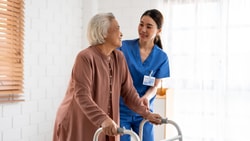Evidence-Based Fall Prevention for Older Adults: From Screening to Strength
Give your patients the tools they need to stay safe and independent. Explore evidence-based fall prevention strategies from clinical practice guidelines to assess risk, build strength, and improve real-world mobility.
August 20, 2025
11 min. read

Falls are among the most common and costly events affecting older adults, particularly those experiencing general deconditioning. But they don’t have to be inevitable. With targeted, evidence-based interventions, clinicians can help patients rebuild strength, stability, and cognitive–motor coordination, reducing both the likelihood of a fall and the severity of injury if one occurs.
Today’s fall prevention strategies go beyond general advice to “be careful.” They start with early risk recognition, guided assessment, and tailored interventions that address both physical and cognitive contributors to instability.
In this article, we’ll break down how low-level strength training and dual-task exercises can be integrated into daily practice, along with multifactorial strategies to help older adults stay safer, stronger, and more independent.
The growing challenge of fall prevention
Every year, millions of older adults experience a fall, often resulting in serious injury, loss of independence, or hospitalization. The connection is clear: reduced activity, whether from illness or lifestyle changes, leads to muscle atrophy and diminished balance, both of which heighten fall risk.
For clinicians, the challenge is twofold: identifying patients at risk early and delivering interventions that are both safe and effective for deconditioned individuals. But there are also systemic barriers that make fall prevention more difficult:
Capacity: Limited availability of outpatient and home rehabilitation services can delay care.
Reimbursement: Insurance restrictions such as benefit caps, in-network limitations, and per-visit copays may limit therapy access.
Opportunity cost: Extended wait times can lead to significant harm; in the U.S., one person dies from fall-related injuries every 20 minutes.1
Access: Travel distance, transportation challenges, and the energy required for frequent appointments can prevent patients from getting the recommended dosage of therapy.
These constraints mean fall prevention must be both strategic and adaptable, making early detection and targeted, evidence-based interventions even more critical.
A structured framework for fall prevention
The evidence-based Clinical Practice Guideline for Falls and Fall Risk outline four phases that help clinicians move from initial screening to long-term monitoring:2
Recognition: Determine whether the patient has a history of falls or is currently at risk.
Assessment: Identify medical, environmental, and functional factors that contribute to risk.
Treatment: Develop and implement a patient-centered plan that reduces risk while preserving dignity, independence, and quality of life.
Monitoring: Reassess over time, document outcomes, and use quality improvement processes to strengthen prevention strategies.
This phased framework ensures that fall prevention is not a one-time intervention but a structured, repeatable process that can be applied across settings, from long-term care to outpatient and home health.
Recognizing and assessing fall risk
Preventing falls starts with accurately identifying who is at risk and why. Risk factors can be:
Intrinsic: Impaired strength, balance, vision, cognition, or chronic conditions
Extrinsic: Poor lighting, cluttered walkways, loose rugs, or other environmental hazards
When we look closer, these factors often overlap. A person with mild vision impairment may have no trouble at home—until dim lighting in a hallway combines with slower reaction time to create a dangerous situation. That’s why identifying risk isn’t just about checking a single box; it’s about understanding the full picture.
Clinicians often reference the CDC’s STEADI framework, which provides a step-by-step approach for moving from a quick screen (“Is this person at risk?”) into a deeper assessment (“Why are they at risk, and what can we do about it?”). STEADI also includes recommended assessments, like the 30-second sit-to-stand test, and patient education resources that address safety topics directly tied to fall prevention.
To make risk recognition even more actionable, you can use the AM-PAC score chart to measure mobility and daily activity limitations. Download our free AM-PAC Score Chart PDF below to support more accurate assessment and track patient progress over time.
AM-PAC Score Chart PDF
Fill out the form to unlock your free PDF!

Why exercise is central to fall prevention
Exercise is at the heart of fall prevention, and for good reason—targeted movement retrains the body to react, recover, and stay upright. Strength training restores muscle capacity, while dual-task training builds the ability to maintain stability when the brain is processing multiple demands.
For deconditioned patients, low-level exercise offers a safe entry point. These aren’t high-intensity workouts—they’re functional movements done at tolerable effort levels, progressing gradually as confidence and capacity improve.
With a clear picture of a patient’s fall risk, the treatment phase is where the real change happens. Here, everything learned so far is transformed into a practical, patient-centered plan designed to improve safety and mobility. That plan might:
Aim to reduce fall frequency, minimize injury severity, or balance safety with a patient’s desire for independence.
Address specific causes of falls, such as gait impairments, dizziness from medications, or vitamin D deficiency.
Include trial-and-error strategies like group exercise classes, home modifications, or environmental changes to see what’s most effective.
Combine exercise with other supports, such as hip protectors or low beds, to reduce harm if a fall occurs.
Targeted exercise strategies for safer mobility
Once a tailored treatment plan is in place, the next step is putting it into action with exercises that build the specific skills patients need to move safely and confidently.
Low-level strength training: The foundation
When it comes to fall prevention, strength is about rebuilding the muscle power needed to handle life’s daily challenges. For many older adults, that starts with low-load, functional exercises that can be done safely at home or in a clinic. The goal is to restore strength in the muscles most critical for balance recovery—quads, hamstrings, glutes, calves, and hip abductors—while keeping intensity at a tolerable level.
Key exercises include:
Sit-to-stand from a chair: Builds leg strength and independence in transfers.
Mini-squat with counter support: Targets quadriceps and glutes with upper-body support.
Heel raises: Improves calf strength for push-off during walking and balance recovery.
Side-stepping with support: Strengthens hip abductors for lateral stability.
Tip: Start with 1–2 sets of 8–10 repetitions, using a stable support surface for safety. Gradually progress patients by increasing reps, reducing hand support, or adding light resistance. Integrating these movements into daily routines, like standing up from a chair without using the arms, boosts both adherence and real-world carryover.
Dual-task training: Preparing for real-world demands
Many falls happen when attention is split—answering a question while walking, carrying groceries through a busy hallway, or scanning for a seat in a crowded room. In these moments, the brain is juggling both movement and mental processing, and if balance reactions aren’t automatic, stability can falter.
Dual-task training addresses this by pairing a motor task with a cognitive challenge, improving the ability to maintain postural control even when the mind is occupied. Balance reactions need to be expedient, reactive, anticipatory, and automatic. That kind of adaptability improves when we intentionally create cognitive–motor interference in a safe, structured way.
Examples include:
Walking while counting backwards from 50.
Stepping in place while naming items in a category (e.g., animals, fruits).
Performing heel-to-toe walking while reciting alternating letters of the alphabet.
Tip: Timing and dosage matter. Begin with simple tasks and short durations, then progress to more complex challenges and longer bouts as tolerance improves. Keep safety in mind, and use a gait belt, stable surface, or therapist supervision when needed.
Addressing the multifactorial nature of falls
Most falls aren’t the result of a single problem—they happen when several risks overlap. A patient might already have mild neuropathy, but add dim lighting, a loose rug, and a moment of distraction, and suddenly the risk spikes. That’s why a strong fall prevention plan goes beyond exercise to address the full picture.
The most effective strategies match each specific risk factor with a targeted intervention:3
Risk factor | Recommended approach |
Prior fall | Strength training and progressive balance retraining to restore confidence and function |
Fear of falling | Patient education, cognitive behavioral strategies, and graded exposure to activities |
Mobility impairment | Task-specific practice and impairment-based balance training with gradual progression |
Pain | Strengthening, physical activity, and exposure-based movement strategies |
Environmental hazards | Patient education, empowerment, and home modifications (e.g., lighting, grab bars, hazard removal) |
Sensory impairment (neuropathy, vestibulopathy, vision) | Somatosensory reweighting, vestibular rehab, and updated corrective lenses or devices |
By addressing these contributing factors alongside targeted exercise, clinicians can reduce not only the likelihood of a first fall, but also the chance it will happen again.
Turning fall prevention strategies into action
Addressing multiple risk factors is essential, but putting those strategies into a clear, repeatable plan is what turns clinical goals into real-world results. With Medbridge’s Fall Prevention Pathways, you can do exactly that: guide patients step-by-step through a progressive, evidence-based program that combines exercise, education, and environmental safety.
Built for both individual and group settings, each pathway is built around the patient’s goals and ability level, with every phase paired with reminders, notifications, and engaging educational content that reinforce learning and keep patients on track.
Some of our key features include:
Evidence-based exercise progressions tailored to each patient’s capacity and goals.
Holistic education modules for patients and caregivers on recognizing and reducing fall risks.
Integrated tracking tools for monitoring improvements and adapting care plans over time.
Flexible delivery options for in-clinic, home health, or community-based programs.
By combining multifactorial fall prevention strategies with a structured, easy-to-follow program, we ensure no critical element is overlooked, making it easier for you to deliver consistent, high-quality care and for patients to build the strength, confidence, and knowledge they need to stay safer, longer.
Monitoring and adapting over time
Fall prevention isn’t a one-and-done effort—it’s an ongoing process that works best with regular check-ins, objective measures, and timely adjustments. Remote Therapeutic Monitoring (RTM) tools make it possible to track adherence and capture outcomes in real time, allowing you to adapt programs quickly based on a patient’s response.
Medbridge Pathways integrates both clinician-led functional assessments and patient-reported outcomes. Each week, patients complete the Short Falls Efficacy Scale–International (FES-I), providing valuable insight into their confidence and fear of falling during daily activities. Monitoring these scores alongside functional measures helps clinicians determine whether interventions are not only improving mobility but also reducing fear.
Whether adjusting exercise dosage, reinforcing fall prevention education, or adding targeted interventions like osteoporosis management, this proactive monitoring ensures patients keep progressing while clinicians can respond quickly to emerging risks. The result: Fall prevention remains a living, responsive part of care, not a static plan on paper.
A patient’s journey through the workflow
Rather than viewing fall prevention as an abstract protocol, it becomes clearer when we follow a patient through each stage of care. The four-phase framework outlined in the Clinical Practice Guideline for Falls and Fall Risk can be mapped onto a structured workflow that combines in-person assessments, remote monitoring, and patient-reported outcomes.
To show how this works in practice, let’s follow James, an 82-year-old retired teacher who was referred to therapy after reporting unsteadiness when climbing stairs and a recent near-fall:
Initial assessment (Day 0): James’ therapist conducts a full in-person evaluation including Berg balance, 30-second sit-to-stand, 4-stage balance, timed up and go, and gait speed. Baseline measures include the FES-I, ABC scale, and a quality-of-life survey. Results show moderate fall risk and high anxiety around leaving his home alone.
Interim assessments (Weeks 1–7): Using Pathways, James receives weekly prompts to complete the Short FES-I, and his progress reports highlight gradual gains in balance and stamina. His therapist modifies his program by adding stair-specific strengthening once he demonstrates improved lower-limb endurance.
Final assessment (8 Weeks): A repeat in-person evaluation reveals measurable improvements: faster TUG times, higher sit-to-stand counts, and a reduced fear-of-falling score. James shares that he feels confident enough to resume his weekly church group, a personal goal identified during intake.
Follow-up Check-ins (13 and 26 Weeks): Pathways reminders prompt James to complete periodic FES-I updates and report any fall incidents. His therapist reviews the data remotely, confirming that his gains are sustained and adjusting his home program to include more outdoor walking as the weather improves.
This workflow not only follows the recognition–assessment–treatment–monitoring cycle, but also demonstrates how technology and structured reassessments can make fall prevention a living, responsive process rather than a one-time intervention.
References
National Center for Injury Prevention and Control. (2017, June 6). Every 20 minutes an older adult dies from a fall in the United States [Infographic]. CDC Stacks. https://stacks.cdc.gov/view/cdc/46789
Vance J. (2012). The clinical practice guideline for falls and fall risk. Translational behavioral medicine, 2(2), 241–243. https://pmc.ncbi.nlm.nih.gov/articles/PMC3717891/
Medbridge. (n.d.). Building pathways to safety: How Medbridge is transforming fall prevention with digital care [Webinar]. Medbridge. https://www.medbridge.com/resource-center/building-pathways-to-safety-how-medbridge-is-transforming-fall-prevention-with-digital-care





